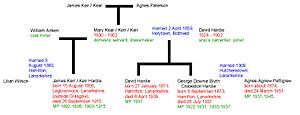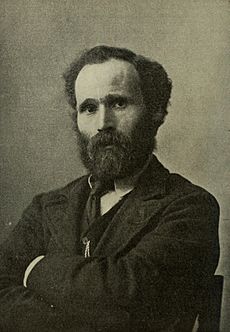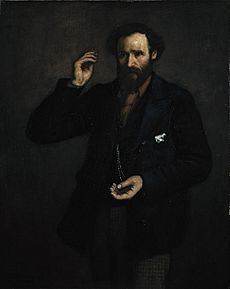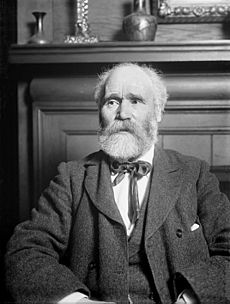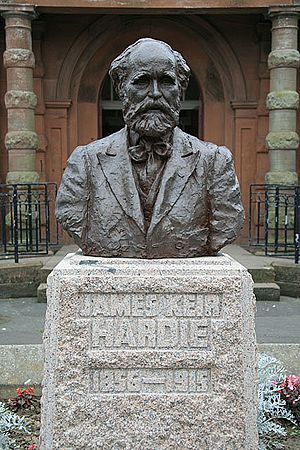Keir Hardie facts for kids
Quick facts for kids
Keir Hardie
|
|
|---|---|
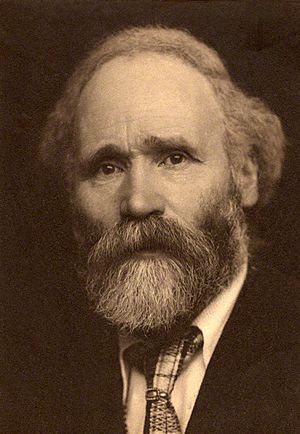
Hardie in 1905 by G. C. Beresford
|
|
| Leader of the Labour Party | |
| In office 17 January 1906 – 22 January 1908 |
|
| Chief Whip | David Shackleton Arthur Henderson George Henry Roberts |
| Preceded by | Office established |
| Succeeded by | Arthur Henderson |
| Member of Parliament for Merthyr Tydfil |
|
| In office 24 October 1900 – 26 September 1915 Serving with Edgar Rees Jones (1910–1915)
|
|
| Preceded by | William Pritchard Morgan |
| Succeeded by | Charles Stanton |
| Member of Parliament for West Ham South |
|
| In office 26 July 1892 – 7 August 1895 |
|
| Preceded by | George Banes |
| Succeeded by | George Banes |
| Personal details | |
| Born |
James Keir Hardie
15 August 1856 Newhouse, Lanarkshire, Scotland |
| Died | 26 September 1915 (aged 59) Glasgow, Lanarkshire, Scotland |
| Political party | Labour |
| Other political affiliations |
Scottish Labour Independent Labour |
| Spouse |
Lillias Balfour Wilson
(m. 1880) |
| Children | 4 |
James Keir Hardie (born August 15, 1856 – died September 26, 1915) was a Scottish leader for workers' rights and a politician. He helped start the Labour Party and was its first leader in Parliament from 1906 to 1908.
Keir Hardie was born in Newhouse, Scotland. He started working when he was just seven years old. By age 10, he was working in the coal mines. He was a good speaker, even preaching sometimes. This helped him become a voice for other miners.
In 1879, Hardie was chosen to lead a miners' union in Hamilton. He also helped set up a big meeting for miners in Dunfermline. He then led miners' strikes in Lanarkshire (1880) and Ayrshire (1881). To earn money, he became a journalist. From 1886, he worked full-time as a union organizer for the Ayrshire Miners' Union.
Hardie first supported the Liberal Party. But he soon realized that working people needed their own political party. In 1888, he ran for Parliament as an independent candidate. Later that year, he helped create the Scottish Labour Party. In 1892, Hardie won a seat in Parliament for West Ham South. The next year, he helped form the Independent Labour Party (ILP).
He lost his seat in 1895 but was re-elected in 1900 for Merthyr Tydfil in South Wales. In the same year, he helped form the Labour Representation Committee. This group later became the Labour Party.
After the 1906 election, Hardie became the Labour Party's first leader in Parliament. He stepped down in 1908 and Arthur Henderson took over. Hardie spent his last years fighting for women's right to vote, self-rule for India, and against World War I. He died in 1915 while trying to organize a strike to stop the war. Many people see Hardie as a very important person in the history of the Labour Party.
Contents
Early Life and Work
James Keir Hardie was born on August 15, 1856. He grew up in a small cottage in Newhouse, Scotland. His mother, Mary Keir, worked as a house helper. His stepfather, David Hardie, was a ship's carpenter. Hardie did not know his biological father, a miner named William Aitken.
His family moved to Govan near Glasgow, where they faced tough financial times. Hardie's stepfather tried to find steady work in shipyards. But jobs were hard to keep because the industry often had ups and downs.
Hardie's first job was at age seven. He was a message boy for a shipping company. He could not go to school much after that. But his parents taught him to read and write in the evenings. These skills were very important for his future learning. He had many low-paying jobs, like helping in a brass shop or for a baker.
Once, a big lockout happened at the Clydeside shipyards. Workers were sent home for six months. Hardie's family had to sell their things to buy food. His small earnings were their only money. One of his siblings got sick and died. His mother was pregnant and could not work. Young James also lost his job for being late. His stepfather went back to work at sea. His mother moved to Newarthill to live with her mother.
At age ten, Hardie started working in the mines. He was a "trapper," opening and closing a door for ten hours a day. This job kept air flowing for the miners. He also started going to night school in Holytown.
Hardie's stepfather came back from sea and worked on a railway. The family then moved to Quarter, Lanarkshire. Hardie worked as a pony driver in the mines. Later, he became a hewer, digging coal. He also worked in quarries for two years. Around this time, he read a book called Sartor Resartus by Thomas Carlyle. This book greatly influenced his ideas about fairness and peace. By age twenty, he was a skilled miner.
Becoming a Union Leader
"Keir," as he was called, wanted a life outside the mines. His mother encouraged him to learn to read and write shorthand. He also joined the Evangelical Union Church and the Temperance movement. Hardie's preaching helped him learn how to speak well in front of crowds. Soon, other miners looked to him to lead their meetings and speak about their problems.
Mine owners started to see him as a troublemaker. Soon, he and his two younger brothers were blacklisted. This meant they could not work in the local mines.
The 23-year-old Hardie then focused on organizing unions. In May 1879, mine owners in Scotland cut wages. This made miners want to form unions even more. Big meetings were held in Hamilton. On July 3, 1879, Hardie became the miners' secretary. This allowed him to connect with other miners' representatives across Scotland.
Three weeks later, miners chose Hardie to go to a National Conference of Miners in Glasgow. In August 1879, he became a Miners' Agent. This started his career as a full-time union organizer.
On October 16, 1879, Hardie went to a miners' conference in Dunfermline. He was chosen as National Secretary. Hardie was very active in the strikes in 1880. This included a six-week strike in the Lanarkshire mines. The new union had no money. But Hardie and others got local shops to give food to striking families. His new wife, Lillie Wilson, even ran a soup kitchen from their home.
The Lanarkshire strike failed, but Hardie's hard work was noticed. He moved to Ayrshire to organize miners there. He spent almost a year building a union of local miners.
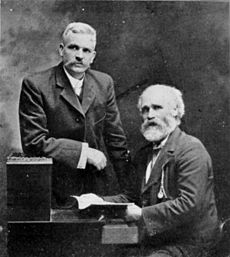
In August 1881, Ayrshire miners asked for a 10 percent wage increase. Mine owners refused. Even without money for strike pay, a strike was called. The mines shut down for 10 weeks. This strike also officially failed. Miners went back to work without their demands met. But soon after, mine owners raised wages. They were afraid of future strikes. One of the strike leaders was 19-year-old Andrew Fisher. He later became the leader of the Australian Labor Party and Prime Minister of Australia. He and Hardie often discussed politics and remained friends.
To earn money, Hardie started writing for the Cumnock News, a local newspaper. He also joined the Liberal Association and continued his temperance work. In August 1886, Hardie's efforts to build a strong union paid off. The Ayrshire Miners Union was formed. Hardie became its Organizing Secretary, earning £75 a year. In 1887, Hardie started his own newspaper called The Miner.
Starting the Scottish Labour Party
For many years, Hardie believed in Georgism, an idea about land ownership. He was also a member of the Scottish Land Restoration League. Through these ideas, he slowly became a socialist. He believed that a government-led socialist system was needed for a better society.
Even though he first supported the Liberal Party, Hardie became unhappy with their economic plans. He felt the Liberals did not truly care about working-class people. Hardie decided that the Liberal Party only wanted workers' votes. They did not want to make the big changes he felt were needed. So, he decided to run for Parliament himself.
In April 1888, Hardie ran as an Independent Labour candidate. He came in last place, but this did not stop him. He believed he would do better in the future. On August 25, 1888, the Scottish Labour Party was founded in Glasgow. Hardie became the party's first secretary. The party's president was Robert Bontine Cunninghame Graham, who was the first socialist Member of Parliament (MP).
MP for West Ham South
In 1892, Hardie was asked to run in West Ham South. This was a working-class area in Essex (now part of Greater London). The Liberal Party did not put forward their own candidate. But they also did not help Hardie. Hardie ran against the Conservative Party candidate. He won with 5,268 votes to 4,036.
When he took his seat in Parliament on August 3, 1892, Hardie refused to wear the usual formal clothes. Other working-class MPs wore black frock coats, top hats, and stiff collars. Instead, Hardie wore a simple tweed suit, a red tie, and a deerstalker hat. The newspapers criticized him, saying he wore a "cloth cap in Parliament." This hat was linked to common working men. In Parliament, Hardie pushed for a fair income tax, free schooling, pensions, and women's right to vote. He also wanted to get rid of the House of Lords.
Forming the Independent Labour Party
In 1893, Hardie and others created the Independent Labour Party (ILP). This worried the Liberals. They were afraid the ILP might take away the working-class votes they usually received.
Hardie made headlines in 1894. There was a terrible explosion at a coal mine in Cilfynydd, killing 251 miners. Hardie asked Parliament to send a message of sympathy to the victims' families. He wanted this added to a message congratulating the Royal Family on a new baby. His request was refused. Hardie then gave a speech criticizing the monarchy. This speech was very controversial. It played a part in him losing his seat in Parliament in 1895.
The Labour Party is Born
Hardie spent the next five years building up the Labour movement. He spoke at many public meetings. He was once arrested at a women's suffrage meeting in London. But the Home Secretary ordered his release. They did not want to arrest the leader of the ILP.
In 1900, Hardie organized a meeting of different trade unions and socialist groups. They agreed to form a Labour Representation Committee. This group later became the Labour Party. That same year, Hardie was elected as an MP for Merthyr Tydfil in South Wales. He represented this area for the rest of his life. Only one other Labour MP was elected that year. But from these small beginnings, the party grew. It formed the first Labour government in 1924.
The Conservative and Liberal Unionist government became very unpopular. The Liberal leader, Henry Campbell-Bannerman, worried about splitting votes with the Labour Party. In 1903, a deal was made. It was called the Lib-Lab pact of 1903. The Liberals agreed not to run candidates against Labour in thirty areas in the next election. This was to avoid splitting the vote against the Conservatives.
In 1906, the Labour Representation Committee changed its name to the "Labour Party." That year, a new Liberal government called a General Election. The Conservatives lost badly, and the Liberals won by a huge amount.
The 1906 general election was one of the biggest wins in British history. The Liberals took seats that were usually safe for the Conservatives. Even the Conservative leader, Arthur Balfour, lost his seat. What was even more important was that 29 Labour MPs were elected.
In January 1907, at the Labour Party's first yearly meeting, Hardie helped discuss who had more power. Was it the yearly meeting or the Labour MPs in Parliament? Hardie even threatened to resign. This was over a rule about women's voting rights. The Labour MPs allowed Hardie to vote as he wished. This became a rule that MPs could vote based on their conscience.
Hardie did not like dealing with arguments within the party. He resigned as party chairman in 1908. Arthur Henderson took his place.
Later Years and Legacy
After stepping down as party leader in 1908, Hardie focused on other causes. He campaigned for women's right to vote. He also worked closely with Sylvia Pankhurst, a famous suffragette. His secretary, Margaret Symons Travers, was the first woman to speak in the Houses of Parliament. She managed to get in on October 13, 1908.
Hardie also fought for India to rule itself. He wanted to end segregation (racial separation) in South Africa. In 1909, he visited the United States. He criticized the divisions among American socialists. This led to discussions about the American Socialist Party joining with unions.
Hardie was a pacifist, meaning he believed in peace. He was shocked by the First World War. He tried to organize a worldwide general strike to stop the war. His views were not popular, even within the Labour Party. But he kept speaking at anti-war protests. He also supported people who refused to fight in the war for moral reasons. Hardie believed that working-class men fighting each other only helped rich capitalists.
Despite his efforts, once the war started, Hardie seemed to accept that it would continue. After several strokes, Hardie died in a hospital in Glasgow on September 26, 1915, at age 59. He died from pneumonia. His friend, Thomas Evan Nicholas (Niclas y Glais), gave the sermon at his memorial service. Hardie was cremated in Glasgow. A memorial stone for him is in Cumnock Cemetery in Cumnock, Scotland.
Hardie's Lasting Impact
On December 2, 2006, a statue of Hardie was unveiled in Aberdare. This was in his old constituency. The ceremony marked 100 years since the Labour Party began.
Hardie is still highly respected in his hometown of Holytown. His childhood home is kept as a museum. The local sports center is named "The Keir Hardie Sports Centre." Keir Hardie Memorial Primary School opened in 1956, named after him. There are now 40 streets across Britain named after Hardie.
One of the buildings at Swansea University is named after him. A main road in Sunderland is called Keir Hardie Way. In Gateshead, the main street of the Ellen Wilkinson Estate is Keir Hardie Avenue. Other streets there are named after early Labour MPs.
The Keir Hardie Estate in Canning Town (Newham, East London) is named after him. This is because he was an MP for West Ham South. Keir Hardie Avenue in Cleator Moor, Cumbria, has been named after him since 1934. An estate in the London Borough of Brent is also named after Hardie. Keir Hardie Crescent in Kilwinning, Scotland, is named after him. So is a block of apartments in Little Thurrock. There are also Keir Hardie Streets in Greenock and Methil, Fife.
Ty Keir Hardie, in his constituency town of Merthyr Tydfil, holds council offices. In Merthyr Tydfil, there is also a Keir Hardie Estate. Its streets are named after other early Independent Labour leaders.
The Keir Hardie Methodist Church in London is named after him. This honors his work as a lay preacher.
In a 2008 poll at the Labour conference, Hardie was voted the party's "greatest hero."
Hardie's younger half-brothers, David Hardie and George Hardie, became Labour MPs after he died. His sister-in-law, Agnes Hardie, also became a Labour MP. His daughter, Nan Hardie, and her husband, Emrys Hughes, both became leaders of Cumnock. Hughes also became a Labour MP in 1946.
Keir Starmer, the current leader of the Labour Party, was named after Hardie. He has said he is "very fond of the name."
Keir Hardie Society
On August 15, 2010, the Keir Hardie Society was founded. This was on the 154th anniversary of Hardie's birth. The society aims to "keep alive the ideas and promote the life and work of Keir Hardie." Among its founders was Cathy Jamieson, an MSP for the area where Hardie lived. Richard Leonard, a Scottish Labour leader, was also a main founder.
In Other Media
In August 2016, a play called A Splotch of Red: Keir Hardie in West Ham was performed. It was shown in different places in Newham. The play is about Hardie's fight to win the West Ham South election.
Works
- From Serfdom to Socialism (1907)
- Karl Marx: The Man and His Message (1910)
- Lua error in Module:Cite_Q at line 12: attempt to index field 'wikibase' (a nil value).
See also
 In Spanish: Keir Hardie para niños
In Spanish: Keir Hardie para niños
- List of peace activists
- List of suffragists and suffragettes


